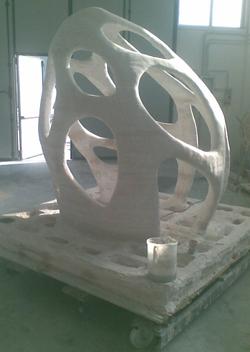Dutch Architect Plans to 3D Print a Building
April 10, 2013

The advent of 3D printing continues to revolutionize the way we approach the creative process. If being able to draw up and print out your very own paper or plastic molds isn't enough, how about printing your own building? That's what Janjaap Ruijssenaars plans to do for the next two years.
The Dutch architect is setting out on a quest to build a structure resembling a Mobius strip using the relatively new D-Shape printer. He has already enlisted the help of two friends: the mathematician-sculptor Rinus Roelofs and Enrico Dini, the man who invented the D-Shape 3D printer. The Landscape House will appear as "one surface folded in an endless mobius band." Just imagine a building whose floors seamlessly transform into ceiling, along with stairs that spiral you from the lower floor to the upstairs level and back down on the opposite end.

How does one actually go about printing an entire building? Using the D-Shape printer, 20-by-30-foot slabs of a concrete-like material will be printed out at 5mm-thick intervals. The D-Shape is essentially a large aluminum structure that uses CAD/CAM software to drive the manufacturing process taking place inside it. The printer uses stereolithography to solidify and join thin layers of sand with the help of an inorganic bonding agent. The result is an exceptional marble-like material with superior traction, compression, and bending strengths that does not require steel reinforcement. It's also 100 percent environmentally friendly.
It is estimated that each building will cost $6 million to print. The first is expected to be completed by 2014, and the backers hope to print at least one Mobius building per country.
Our creative capabilities continue to expand, even more so now that manufacturing techniques using 3D printing are beginning to catch up with the design potential of advanced CAD software. The work of Ruijssenaars and his partners shows how humans are slowly bridging the gap between imagination and ingenuity.
Related posts:
About the Author(s)
You May Also Like





